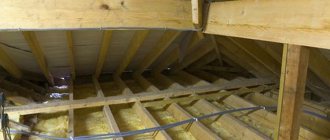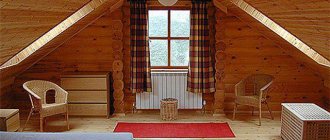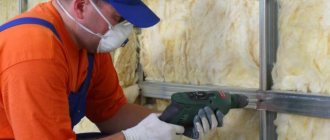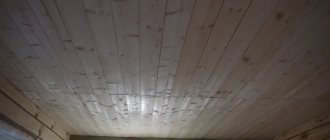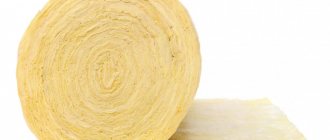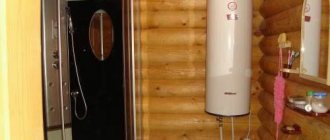Therefore, more and more often people are building steam rooms on their plots: a place for a pleasant relaxation with family and company. However, even experienced house builders do not always know the nuances that will have to be encountered when building a bathhouse. What material is better to choose for the walls, how and what is the best way to insulate the ceiling in a bathhouse...
Constant humidity, temperature changes, high requirements for hygiene and heat resistance of materials - all this complicates the construction process. Let's try to figure out what materials are best to use and what are the difficulties of the process of insulating the ceiling in a bathhouse.
Why insulate the ceiling?
Insulating the ceiling in a bathhouse is one of the most important elements of construction. Heat leakage will not allow you to create the correct temperature and microclimate, which means it is unlikely that you will be able to steam comfortably in such a bathhouse.
To understand why special attention needs to be paid to the ceiling, remember your school physics lessons. Warm air always rises and when it cools it falls. This means that it is impossible to limit ourselves to insulating only the floor and walls - the heated air rises to the cold ceiling and goes down to people who want to take a good steam.
Proper ceiling insulation will help you avoid this situation and save time and effort on heating the steam room. In addition, this design significantly reduces the cost of heating the bathhouse.
Important point: It is recommended to insulate the bathhouse ceiling both outside and inside. This way you can achieve maximum results.
In many ways, proper ceiling insulation depends on the selected materials. Their diversity can confuse an inexperienced builder. However, after studying each of the options in more detail, considering all their pros and cons, you will be able to choose the best option.
Expert advice
For bath structures, the criterion of environmental friendliness of the insulation is important, so it is better to choose natural heat insulators that meet fire safety standards. Expanded clay, prepared sawdust-cement backfills, and vermiculite are well suited for thermal insulation. They can be installed independently, following installation technology.
When installing insulation, you need to build a protective steel box for the chimney pipe.
Expanded clay can be poured into the box. It is necessary to ensure that wooden structures do not touch the chimney.
When insulating with mineral wool, it is better to choose multi-layer installation with overlapping of previous joints. This method will avoid heat leakage through the seams of the insulation. This will not affect the cost of the heat insulator, since it is sold in cubic meters. There is no need to exceed the thickness of the planned layer, but choose a thinner roll of cotton wool.
Foil materials are more relevant for bath buildings
, since the foil reflects infrared heat rays from the ceiling, improving the heating rate of the steam room. This reduces heating costs. The vapor barrier with foil is laid with the reflective side down. To fix the joints of vapor barrier films, foil tape is used. To form a sealed vapor barrier, the seams are overlapped by 10 cm and then secured.
The thickness of the installed layer of a specific heat insulator is calculated based on climatic conditions and the thermal conductivity coefficient of the material.
The average thickness of the thermal insulation layer for natural insulation materials is 25-35 cm, for artificial materials - 15-20 cm.
The greater the temperature difference between the environment and the heated steam room, the faster the hot air tends to leave the room. Proper sealing of all cracks, gaps and technological openings will prevent rapid heat loss. A monolithic thermal insulation layer with a sealed reflective vapor barrier will significantly reduce heat loss.
How and with what to insulate a bathhouse, see the following video.
External roof insulation
This type of insulation allows the use of materials that are not highly resistant to moisture (they are often cheaper). The insulation is located inside the bath attic, so steam does not penetrate to it, forming condensation.
How to insulate the ceiling of a bathhouse from the outside? There is no single answer to this question. Each builder has his own preferences. After analyzing them, we can highlight several of the most popular options:
- Mineral wool. Made from basalt fiber using an industrial press, this material practically does not conduct heat. At the same time, it is highly resistant to both temperature changes and aggressive external environments. Such insulation can be used without fear that it will fail in a couple of years. However, it also has its drawbacks: the high thermal insulation ability is instantly lost as soon as the mineral wool gets wet. In addition, the material is quite brittle. Thus, microparticles that are quite harmful to humans can enter the interior. Thus, mineral wool is recommended for use for external insulation and is strictly prohibited for internal insulation.
Please note: It is recommended to lay an insulating layer between the ceiling and the mineral wool. Most often, industrial construction moisture-resistant film is used for it.
- Expanded clay is a natural material obtained from baked clay. Its durability and low cost compared to most synthetic insulation brought it great popularity. Such material is practically not subject to decomposition. In addition, it does not emit toxic fumes. At the same time, its high thermal insulation properties make it one of the best options, and its fire resistance significantly reduces the likelihood of a fire. The low weight of expanded clay is another factor for choosing it as a material for ceiling insulation. It should be taken into account that the process of laying it is quite labor-intensive and takes a lot of time. In addition, expanded clay quickly loses its properties when exposed to moisture and steam - which is why it is mainly used for external insulation.
Many people recommend using sawdust, clay, and earth for insulation. But you need to take into account that these materials tend to retain water, which means that over time they will lose their properties.
In addition, accumulated water gradually adds weight to the material. There is a risk of gradual destruction of the ceiling, which is fraught with an emergency situation.
Therefore, when choosing materials for external insulation, give preference to mineral wool or expanded clay: they have successfully proven themselves and have been used in the construction of baths for a long time, receiving practically no negative reviews.
As for the internal insulation of the bath ceiling, the list of options is much wider. Of course, you can use the materials suggested below for external insulation - however, their price is much higher. At the same time, the properties often differ only in increased moisture resistance - so is it worth overpaying?
Let's take a closer look at what needs to be done if you want to insulate the ceiling in a bathhouse with your own hands.
Origin and manufacturers
The thermal properties of cellulose were familiar to people back in the century before last. It was then that thermal insulation technology based on recycled paper was patented. But such trends reached the post-Soviet space relatively recently, only in the 1990s. The fine fraction of cellulose fibers is crushed and foamed in production, but the matter does not end there. The mass must be treated with antiseptic and fire-retardant compounds that suppress rotting and inflammation and prevent the material from molding.
The environmental purity of the material is not compromised by special processing - this is a product that is produced only with natural ingredients. Flame suppression is provided by borax, occupying up to 12% of the mass. To prevent ecowool from rotting, it is necessary to use up to 7% boric acid. In Russia there are now about a dozen companies producing ecological wool. The main positions in the market are occupied by Ekovata LLC, Urallesprom, Promekovata, Vtorma-Baikal, Equator and some others.
Internal ceiling insulation
Insulating the ceiling in a bathhouse with a cold roof is not the easiest task. All your efforts to design and build a well-thought-out steam room can go wrong if the air quickly cools, rising to the ceiling.
Therefore, builders recommend paying close attention to the insulation of the ceiling. Even cool walls and floors do not affect the microclimate in the steam room as destructively as an improperly insulated ceiling.
Important: Remember that the material for internal insulation must first of all have increased moisture resistance and non-toxicity!
Remember that high temperatures and high humidity in the bathhouse and, especially in the steam room, complicate the process a little. If you want to insulate the ceiling in a bathhouse without an attic yourself, you need to carry out a number of preparatory work:
- First of all, you should sheathe the ceiling with fairly thick planks (often the minimum width is six centimeters).
- Then a vapor barrier should be installed. Modern hardware stores can offer you a large number of options. However, construction films, aluminum foil or cardboard impregnated with drying oil are still considered optimal.
- Only after this should you start laying the insulation directly for the bathhouse ceiling. Its thickness must be at least fifteen centimeters!
If you want to insulate the ceiling in a bathhouse with an attic, you must first carry out these manipulations in the attic to insulate the roof. After this, insulate the room from the inside, following the instructions for the material you have chosen.
Damask
This insulation is made from seaweed, or rather, its storm emissions. Zostera is common in the Black Sea, so the material can be called domestic and affordable. Kamka is a good heat and sound insulator. The algae are distinguished by a high content of calcium salts, so insects and rodents do not grow in the stone.
Damask is capable of removing moisture from the room if there is excess moisture, and if the air is too dry, on the contrary, releasing it. This creates a good indoor microclimate. An additional plus is that seaweed contains useful substances such as iron, iodine, and fucoidan polysaccharide. The mild smell of iodine has a beneficial effect on the human nervous and respiratory system, so damask can even be called a medicinal insulation.
Such natural plant insulation materials, of course, include straw; we have devoted a separate article to this material and construction from it.
Insulation of the ceiling in a bathhouse with clay
Clay is a material for bath insulation, proven over centuries. The technology has been improved over many years, and therefore is considered one of the most reliable.
In addition to being cheap and highly reliable, clay insulation for baths is considered one of the most environmentally friendly. It does not contain toxic substances, which means it will make wellness treatments even more beneficial.
In addition, clay repels mice, rats and insects - you don’t have to worry about parasites in the sauna.
Interesting fact: Due to the physical properties of clay, it helps maintain the microclimate in the steam room. First, the clay absorbs hot steam, and then gradually releases it, significantly increasing the cooling time of the air in the bathhouse.
However, there were some downsides. The process of laying clay insulation on the ceiling in a bathhouse is quite labor-intensive and not everyone can handle it alone.
To insulate the ceiling with clay yourself, you need to sequentially lay several layers of pre-prepared clay, filling the intermediate layers with expanded clay or sawdust.
Preparing the clay is not difficult: you just need to moisten it a little and mix it with chopped straw. The mixture should resemble soft plasticine - this will make the work much easier.
You will need three to four layers of clay, five to six centimeters thick. This insulation will dry in about a month. If you notice cracks after drying, do not worry - just coat them with another thin layer of clay.
Equipment
Professional equipment for applying ecowool
To apply ecowool, special blowing equipment is used. They differ in cost, size, technical characteristics, and performance. All installations are easy to operate. Pressed cellulose briquettes are placed in a receiving hopper, the machine performs the transformation, and blows the material into the cavity. Blowing units have replaceable nozzles for dry and wet installation. The equipment costs a lot, but it is possible to rent. There are also homemade variations of units for the production of ecowool with your own hands.
We'll tell you how to sheathe the outside of a wooden house and not make mistakes.
We install an acrylic bathtub ourselves.
Details about expanded clay concrete - https://zg-dom.ru/stroitelstvo-doma/stroitelnye-materialy/keramzitobetonnye-bloki-i-ih-harakteristiki.html
Insulation of a bathhouse ceiling with expanded clay
Another simple and quick way to insulate a bathhouse is using expanded clay. Foamed baked clay is a lightweight and comfortable material. The advantages of expanded clay, as in the case of ordinary clay, include its environmental friendliness and low cost.
However, you need to take into account that expanded clay easily absorbs moisture. Unlike clay, it does not simply give it away, but is gradually destroyed under its influence. If you want to insulate the ceiling of a bathhouse from the inside with expanded clay, you should first lay a waterproofing layer.
To install this type of insulation with your own hands, you first need to line the ceiling with boards, then lay a layer of waterproofing material on it - for example, foil or construction moisture-proof film. Then pour a layer of expanded clay (about twenty centimeters). Please note that the thickness of the ceiling beams must correspond to the expanded clay layer. Only after this can the ceiling be sheathed with a finishing board.
Important nuance: Do not mix expanded clay with sawdust. Increased humidity can lead to rotting of sawdust and a decrease in the properties of insulation!
Why is thermal insulation needed?
In order for all the advantages described above to be fully revealed to the owner, it is necessary to properly insulate the walls of the bathhouse. Construction work carried out in full compliance with all norms and standards is unable to retain heat, and therefore will negate the usefulness of bathing procedures, since the room will not be able to warm up to the required temperature. One possible solution to this problem is to reduce the time between adding fuel to the stove, but then the costs of maintaining the required temperature will increase.
Insulating your bathhouse will help you avoid unnecessary costs and experience all the benefits of a steam room. It is preferable to carry out such work at the stage of construction of the building, but if due to certain circumstances this could not be done, then it is possible to implement thermal insulation after construction. The main difference between work of this kind in a house and a bathhouse is that the latter requires a more thorough approach, since it is necessary to maintain an acceptable temperature for a long time. In this regard, it is necessary to take a thorough approach to carrying out thermal insulation work.
There are several main reasons:
- such a room heats up faster;
- comfortable temperature lasts much longer;
- reduction of fuel consumption required for heating;
- such a bath will last much longer.
Bathroom insulation with foam plastic
Despite the fact that polystyrene foam is a popular material, often used to insulate bath ceilings, it has a number of its own nuances. If you want to use polystyrene foam for internal insulation, keep in mind that high-quality waterproofing is the key to your safety!
Polystyrene foam is a lightweight, inexpensive and convenient construction material. However, when heated, it can begin to release substances that are harmful to human health. Therefore, it is necessary to treat the foam layer with thermal insulation and a building mixture or clay.
When insulating a bathhouse with your own hands, polystyrene foam is laid on the ceiling, previously lined with two- to three-centimeter boards. Isolates and a mixture are placed on top of the material, which will prevent harmful fumes. Then the structure is sheathed with a finishing board.
Please note that when using foam plastic for internal insulation of a bathhouse, ventilation is required!
The main positive characteristics of ecowool
The main advantages of ecowool, which make it stand out among its competitors, include:
- Excellent sound insulation. Elastic cellulose fibers repeatedly interlocked with each other perfectly absorb sound waves. One and a half centimeters of ecowool reduces the sound by 9 decibels. This property was appreciated by designers of airport terminal buildings, concert halls and recording studios.
- The low density of ecowool determines its economical consumption. A cubic meter of finished insulation weighs only 25 to 65 kg. For comparison: a cubic meter of mineral wool weighs from 65 to 210 kg.
Ecowool in opened packaging
- Excellent penetrating ability. Ecowool can be blown into the most inaccessible places; the fibers evenly fill cavities and sinuses in building structures. This makes the material an excellent choice for thermal insulation of both already erected buildings and buildings under construction.
- The absence of seams and joints significantly increases the total thermal insulation - up to 10% of heat loss when insulating with mineral wool passes through loose joints, remaining or emerging gaps.
- Almost zero allergenicity and carcinogenicity. The substances that make up the material are harmless to human health both during use and during operation.
- The material repels rodents and insects. When dismantling the renovation of houses insulated with ecowool, no passages gnawed by mice were found in it. The components of the material prevent the development of microorganisms, mold and mildew.
- Combination of high quality and affordable price.
Bath insulation with mineral wool
All the properties of mineral wool used to insulate a bath ceiling have already been described above. Let us remind you that, despite its excellent ability to retain heat, it does not have moisture-resistant characteristics and tends to crumble, which is dangerous to human health.
However, mineral wool is used quite often to insulate the ceiling in a bathhouse. There is a way to smooth out its shortcomings, while maintaining all the advantages of this inexpensive material.
When laying mineral wool, construction foil is used to insulate the bath ceiling. It is laid in two or three layers, overlapping, on a layer of mineral wool. This helps seal the material from moisture and prevent it from shedding.
The resulting multilayer insulation is sheathed with finishing boards. Thus, mineral wool not only increases its heat-reflecting properties, but also loses its disadvantages.
Important nuance: Foil does not allow moisture to evaporate, so we strongly recommend treating the boards with a special mortar.
Flaws
With quite a large number of advantages, it seems that the material can no longer have any disadvantages. And we can say that this is really so. But still, some things can be attributed to disadvantages.
- When installing ecowool, special equipment is required.
- Installation is quite complicated, you need to hire special workers. Which will bring additional costs.
- When using the wet installation method, the material dries in 2 to 3 days. The dry method produces a lot of dust.
- It is not possible to carry out frameless insulation.
- Ventilation is a must.
If all these conditions are met, the material will provide maximum efficiency.
Bath insulation made of foamed polyethylene
One of the most modern ways to insulate the ceiling of a bathhouse is foamed polyethylene. Eco-friendly, perfectly reflecting heat and not retaining moisture, it is excellent for internal insulation.
One of its main advantages is the thinness of the desired layer. Foamed polyethylene is sold in the form of a roll with a reflective coating, several millimeters thick. It is enough to lay a layer of this insulator on the ceiling and cover it with finishing boards.
Polyethylene is recommended for installation in bathhouses with an attic - in this case, you will receive thin insulation in the room itself, and a denser layer for the attic. This way your bath will be reliably protected from heat loss.
Whatever type of insulation for the bathhouse ceiling you choose, remember that all work must be carried out in compliance with construction safety measures!
Use only high-quality materials and carefully study the recommendations for each of them - this way your bath will be warm, reliable and safe.
Ecowool
It's time to think about what influence we, voluntarily or unwittingly, have on the world around us, on ourselves and on the people close to us. Therefore, construction companies in Europe and the West are concerned not only with how to build a house at the lowest cost, but also strive to use environmentally friendly materials in construction. The demand from consumers of construction services for safe materials has also increased. Many are willing to overpay, but live in a clean environment at home and not pollute the environment. This is the choice of modern man. There is no need to overpay for ecowool, nor do you have to doubt its environmental friendliness. Definitely a budget option, affordable for many, but guaranteeing safety, energy saving and care for natural resources.
Step-by-step instructions for DIY construction
In order for construction to proceed correctly, it is worth following the technology step by step:
- Foundation. It is recommended to use a strip foundation to reduce the load on the foam blocks. Formwork is made using boards, and for beacons I use nylon cord. A protective waterproofing layer must be installed at the foundation. Roofing felt or a layer of bitumen mastic is well suited for this.
- Construction of walls . For construction, blocks with strength D600-D800 are used, the first 2 rows are laid on a cement-sand mortar, then an adhesive composition can be used.
Experts say that the first 2 rows need to be reinforced, but some builders talk about reinforcing every 4-5 rows of bathhouse masonry. Openings for windows and doors also need reinforcement. A metal mesh with small cells is suitable for this. The foundation is reinforced with rods.
- Masonry . The blocks are laid only on the edge, while the vertical level is checked with a plumb line.
The photo shows step-by-step construction of a bathhouse:
The thickness of the joining seam should not exceed 5 mm. If the seams are too thick, this will contribute to the formation of cold bridges.
Estimate
Bathhouse construction estimate
To make it easier to calculate your upcoming income, you should make an approximate list of work. It will look something like this:
- Creating a project. At the same time, you cannot do without an architect who will make all the drawings in accordance with the requirements. For example, a typical construction project from 6.5 m*6.5 m timber in a private company can cost approximately $250 or 8,000 rubles.
- Foundation. Prices for the necessary materials depend on where they are purchased.
- Walls and roof. Here you will need to purchase roofing covering.
- Shelves.
- Communications.
- Bake.
- Laying insulation.
- Finishing work.
- Consumables.
- Additional expenses.
The last article may be the largest, since it depends on the individual requirements of the customer. For example, if you take the standard option, then this will be a minor expense, but if you want a jacuzzi, you will have to spend money. This column should also include the purchase of equipment and tools.
Floors
For floor joists it is better to use 100*150 mm timber. You will need 8 pieces of it. * 636 = 5088 rub. The subfloor will require 26 inch boards with a width of 150 mm. ( 4,136 ). If the floors in the entire bathhouse are wooden, then 26 pieces of floorboards will also be required. *590 = 15340 rub. The floor insulation should be good and amount to 150 mm. It will take 27 packs of insulation *430 rubles = 11610 rubles. Total by gender: 36,174 rubles.



